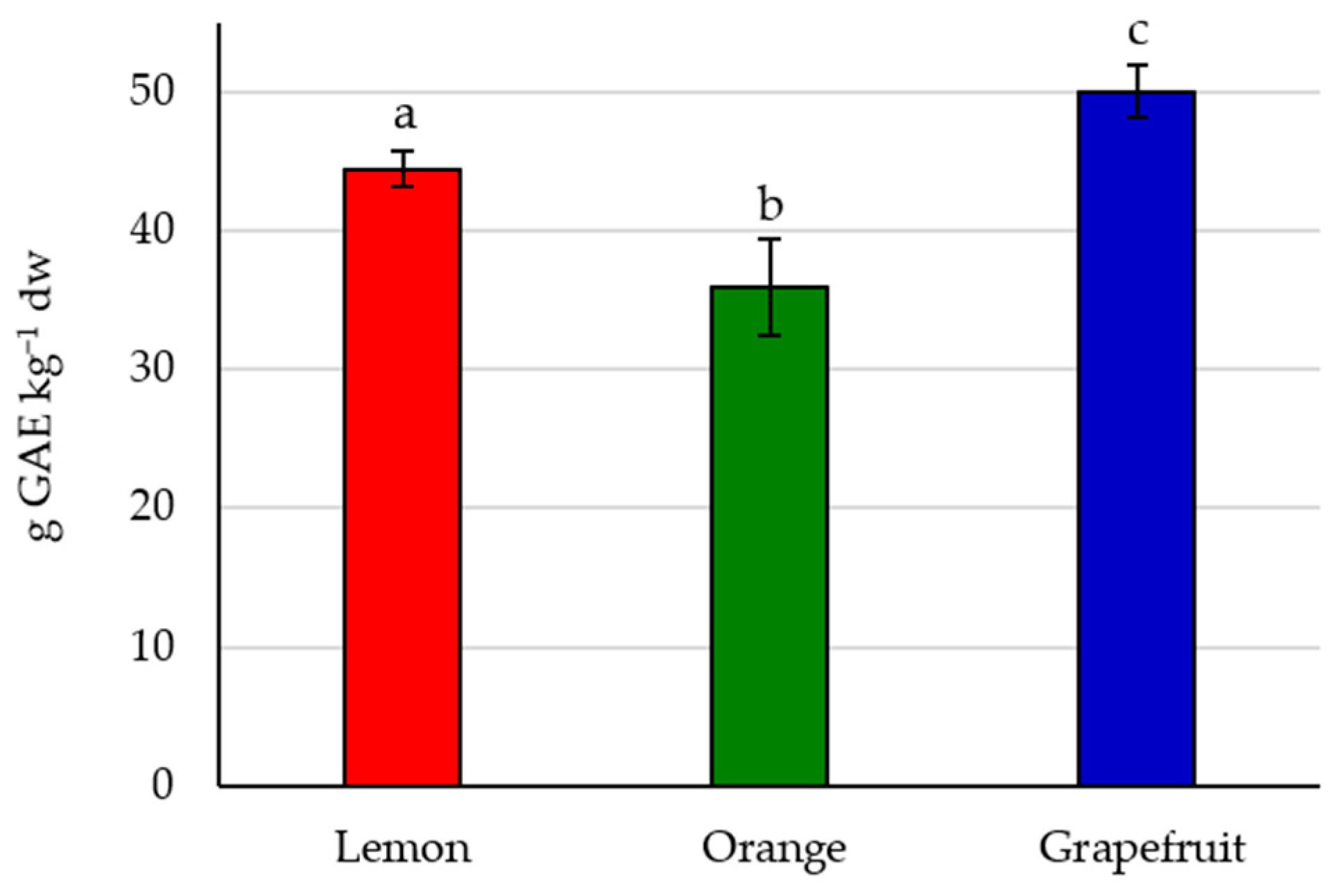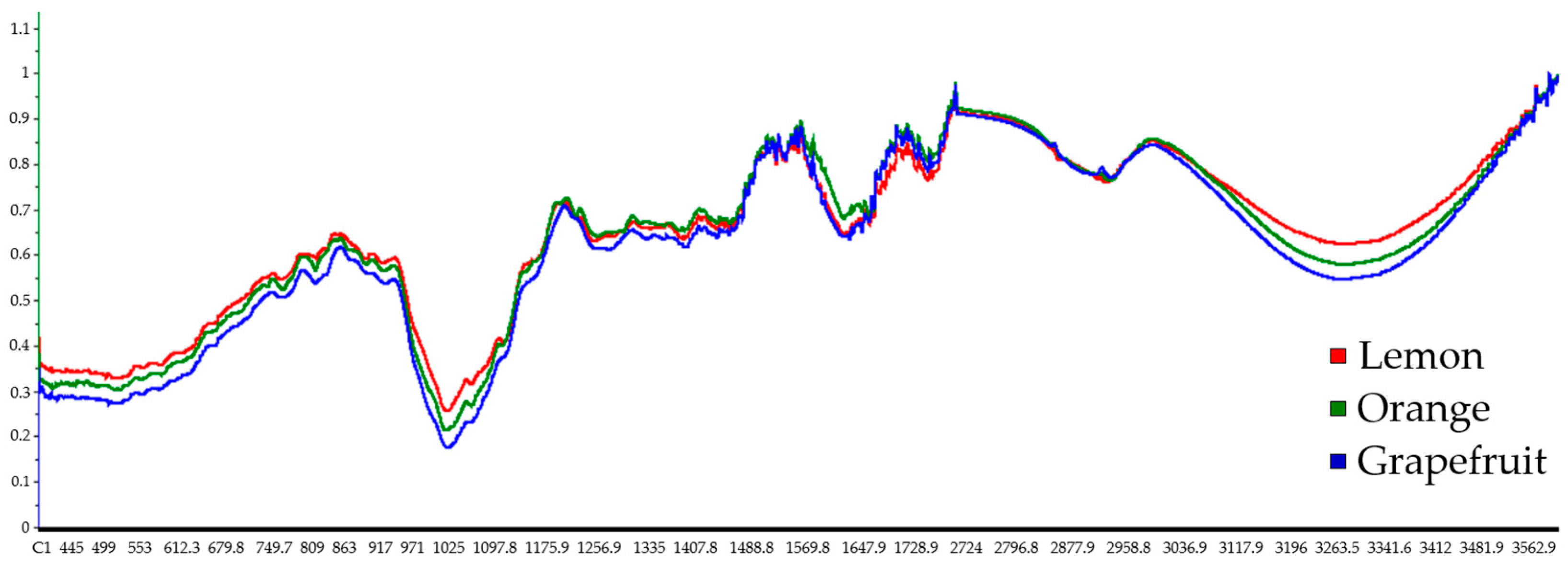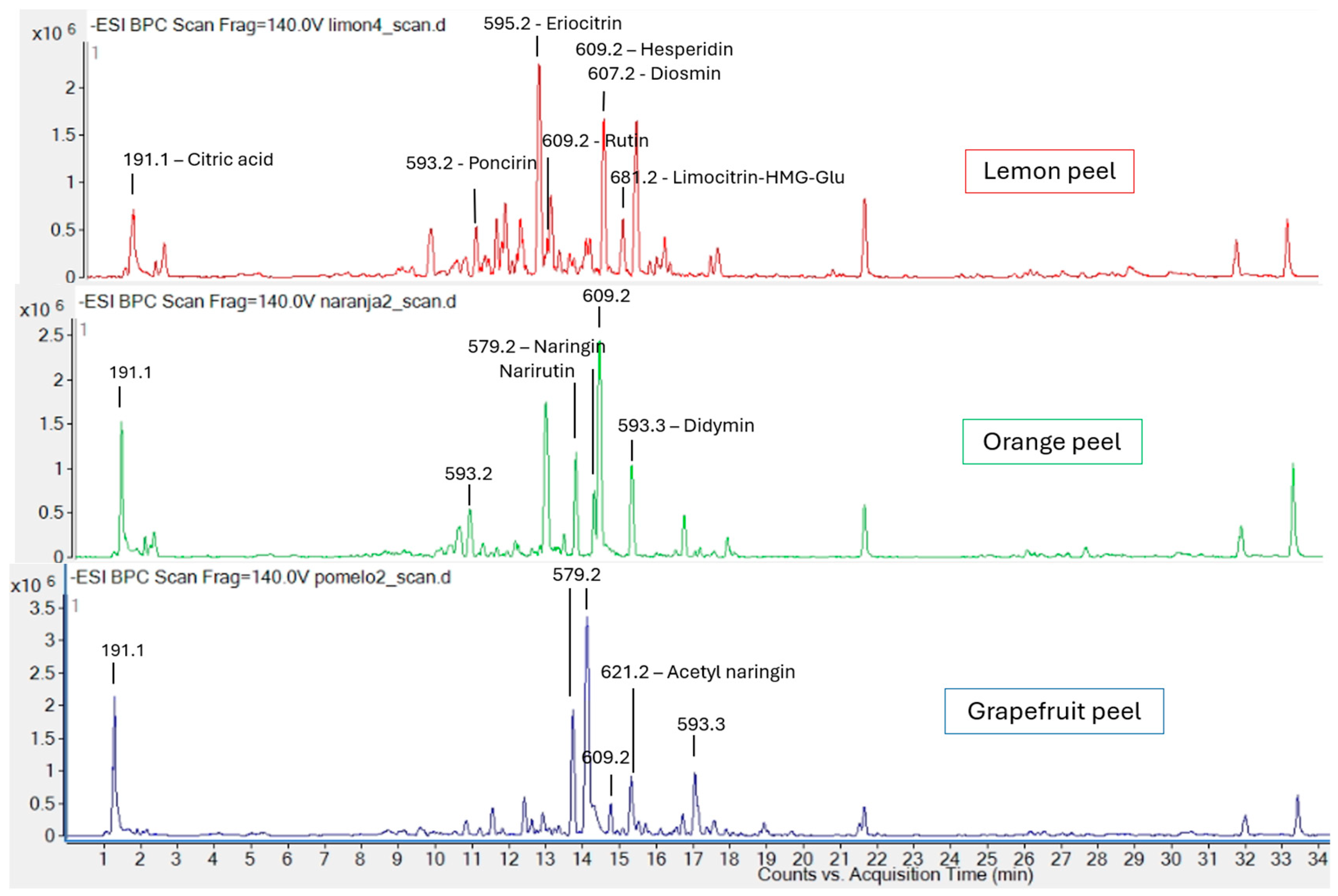Diversity of Color, Infrared Spectra, and Phenolic Profile Correlation in Citrus Fruit Peels †
Abstract
1. Introduction
2. Materials and Methods
2.1. Chemical Reagents
2.2. Plant Materials
2.3. Color Measurement and Fourier Transform Infrared Analysis
2.4. Total Phenolic Content and HPLC-ESI-QqQ-MS/MS Profile Analyses
2.5. Principal Component Analysis and Statistical Analyses
3. Results and Discussion
3.1. Color and Total Phenolic Content
3.2. FTIR Spectrum Analysis and HPLC-MS/MS Profile
3.3. Principal Component Analysis
4. Conclusions
Author Contributions
Funding
Institutional Review Board Statement
Informed Consent Statement
Data Availability Statement
Acknowledgments
Conflicts of Interest
References
- Suri, S.; Singh, A.; Nema, P.K. Recent advances in valorization of citrus fruits processing waste: A way forward towards environmental sustainability. Food Sci. Biotechnol. 2021, 30, 1601–1626. [Google Scholar] [CrossRef]
- Nieto, G.; Fernández-López, J.; Pérez-álvarez, J.A.; Peñalver, R.; Ros, G.; Viuda-martos, M. Valorization of citrus co-products: Recovery of bioactive compounds and application in meat and meat products. Plants 2021, 10, 1069. [Google Scholar] [CrossRef] [PubMed]
- Food and Agriculture Organization of the United Nations FAOSTAT. Available online: https://www.fao.org/faostat/en/#data/QCL (accessed on 16 January 2025).
- Leporini, M.; Tundis, R.; Sicari, V.; Loizzo, M.R. Citrus species: Modern functional food and nutraceutical-based product ingredient. Ital. J. Food Sci. 2021, 33, 63–107. [Google Scholar] [CrossRef]
- Mahato, N.; Sharma, K.; Sinha, M.; Cho, M.H. Citrus waste derived nutra-/pharmaceuticals for health benefits: Current trends and future perspectives. J. Funct. Foods 2018, 40, 307–316. [Google Scholar] [CrossRef]
- Lv, X.; Zhao, S.; Ning, Z.; Zeng, H.; Shu, Y.; Tao, O.; Xiao, C.; Lu, C.; Liu, Y. Citrus fruits as a treasure trove of active natural metabolites that potentially provide benefits for human health. Chem. Cent. J. 2015, 9, 1–14. [Google Scholar] [CrossRef] [PubMed]
- Zhong, G.; Shen, J.; Chen, Z.; Lin, Z.; Long, L.; Wu, J.; Long, C.; Huang, S.; Lian, P.; Luo, G. Antioxidant and antitumor activities of newly synthesized hesperetin derivatives. Molecules 2022, 27, 879. [Google Scholar] [CrossRef] [PubMed]
- Alghareeb, S.A.; Alsughayyir, J.; Alfhili, M.A. Eriocitrin disrupts erythrocyte membrane asymmetry through oxidative stress and calcium signaling and the activation of casein kinase 1α and rac1 gtpase. Pharmaceuticals 2023, 16, 1681. [Google Scholar] [CrossRef] [PubMed]
- Raghavan, S.; Gurunathan, J. Citrus species—A golden treasure box of metabolites that is beneficial against disorders. J. Herb. Med. 2021, 28, 100438. [Google Scholar] [CrossRef]
- Wang, Y.; Qian, J.; Cao, J.; Wang, D.; Liu, C.; Yang, R.; Li, X.; Sun, C. Antioxidant capacity, anticancer ability and flavonoids composition of 35 citrus (citrus reticulata blanco) varieties. Molecules 2017, 22, 1114. [Google Scholar] [CrossRef] [PubMed]
- Anuradha, N.; Kumar, S.S.; Himabindu, N.; Gnanavel, A.; Karthick, S. Quantitative analysis of phytocompounds and gas chromatography mass spectrometry profiling of methanolic extract of citrus limon peel: An experimental study. J. Clin. Diagn. Res. 2024, 18, 7. [Google Scholar] [CrossRef]
- Agócs, A.; Nagy, V.; Szabó, Z.; Márk, L.; Ohmacht, R.; Deli, J. Comparative study on the carotenoid composition of the peel and the pulp of different citrus species. Innov. Food Sci. Emerg. Technol. 2007, 8, 390–394. [Google Scholar] [CrossRef]
- Fayek, N.M.; Farag, M.A.; Abdel Monem, A.R.; Moussa, M.Y.; Abd-Elwahab, S.M.; El-Tanbouly, N.D. Comparative metabolite profiling of four citrus peel cultivars via ultra-performance liquid chromatography coupled with quadrupole-time-of-flight-mass spectrometry and multivariate data analyses. J. Chromatogr. Sci. 2019, 57, 349–360. [Google Scholar] [CrossRef]
- Huang, R.; Zhang, Y.; Shen, S.; Zhi, Z.; Cheng, H.; Chen, S.; Ye, X. Antioxidant and pancreatic lipase inhibitory effects of flavonoids from different citrus peel extracts: An in vitro study. Food Chem. 2020, 326, 126785. [Google Scholar] [CrossRef]
- Martinidou, E.; Michailidis, M.; Ziogas, V.; Masuero, D.; Angeli, A.; Moysiadis, T.; Martens, S.; Ganopoulos, I.; Molassiotis, A.; Sarrou, E. Comparative evaluation of secondary metabolite chemodiversity of citrus genebank collection in greece: Can the peel be more than waste? J. Agric. Food Chem. 2024, 72, 9019–9032. [Google Scholar] [CrossRef]
- Magalhães, D.; Vilas-Boas, A.A.; Teixeira, P.; Pintado, M. Functional ingredients and additives from lemon by-products and their applications in food preservation: A review. Foods 2023, 12, 1095. [Google Scholar] [CrossRef] [PubMed]
- Borba, A.; Gómez-Zavaglia, A. Infrared spectroscopy: An underexploited analytical tool for assessing physicochemical properties of food products and processing. Curr. Opin. Food Sci. 2023, 49, 100953. [Google Scholar] [CrossRef]
- Aftab, J.; Abbas, M.; Sharif, S.; Mumtaz, A.; Zafar, K.; Ahmad, N.; Mohammed, O.A.; Nazir, A.; Iqbal, S.; Iqbal, M. LC-MS/MS profiling, antioxidant potential and cytotoxicity evaluation of Citrus reticulata albedo. Nat. Prod. Commun. 2024, 19, 1934578X241272471. [Google Scholar] [CrossRef]
- Chaudhary, S.; Singh, B.; Srivastava, Y.; Chahal, T.S. Grapefruit albedo-incorporated pasta: Effect on the phytochemical, functional, textural, cooking and sensorial properties of semolina pasta. J. Food Meas. Charact. 2024, 18, 8530–8539. [Google Scholar] [CrossRef]
- Song, S.Y.; Kim, C.H.; Im, S.J.; Kim, I.J. Discrimination of citrus fruits using ft-ir fingerprinting by quantitative prediction of bioactive compounds. Food Sci. Biotechnol. 2018, 27, 367–374. [Google Scholar] [CrossRef]
- Suri, S.; Singh, A.; Nema, P.K.; Malakar, S.; Arora, V.K. Sweet lime (Citrus limetta) peel waste drying approaches and effect on quality attributes, phytochemical and functional properties. Food Biosci. 2022, 48, 101789. [Google Scholar] [CrossRef]
- Zapata, R.; Martínez-Zamora, L.; Cano-Lamadrid, M.; Artés-Hernández, F. Wounding citrus peel by-products as abiotic stress to induce the synthesis of phenolic compounds? Horticulturae 2024, 10, 885. [Google Scholar] [CrossRef]
- Singleton, V.L.; Rossi, J. A colorimetry of total phenolics with phosphomolybdic-phosphotungstic acid reagents. Am. J. Enol. Vitic. 1965, 16, 144–158. [Google Scholar] [CrossRef]
- Castillejo, N.; Martínez-Zamora, L.; Artés-Hernández, F. Postharvest UV radiation enhanced biosynthesis of flavonoids and carotenes in bell peppers. Postharvest Biol. Technol. 2022, 184, 111774. [Google Scholar] [CrossRef]
- Nenadis, N.; Lazaridou, O.; Tsimidou, M.Z. Use of reference compounds in antioxidant activity assessment. J. Agric. Food Chem. 2007, 55, 5452–5460. [Google Scholar] [CrossRef] [PubMed]
- Salas-Millán, J.Á.; Aznar, A.; Conesa, E.; Conesa-Bueno, A.; Aguayo, E. Functional food obtained from fermentation of broccoli by-products (stalk): Metagenomics profile and glucosinolate and phenolic compounds characterization by LC-ESI-QqQ-MS/MS. LWT 2022, 169, 113915. [Google Scholar] [CrossRef]
- Guimarães, R.; Barros, L.; Barreira, J.C.M.; Sousa, M.J.; Carvalho, A.M.; Ferreira, I.C.F.R. Targeting excessive free radicals with peels and juices of citrus fruits: Grapefruit, lemon, lime and orange. Food Chem. Toxicol. 2010, 48, 99–106. [Google Scholar] [CrossRef] [PubMed]
- Pretsch, E.; Bühlmann, P.; Affolter, C. IR spectroscopy. In Structure Determination of Organic Compounds; Springer: Berlin, Germany, 2009. [Google Scholar]
- Sanches, V.L.; Cunha, T.A.; Viganó, J.; de Souza Mesquita, L.M.; Faccioli, L.H.; Breitkreitz, M.C.; Rostagno, M.A. Comprehensive analysis of phenolics compounds in citrus fruits peels by UPLC-PDA and UPLC-Q/TOF MS using a fused-core column. Food Chem. X 2022, 14, 100262. [Google Scholar] [CrossRef]
- Li, P.; Yao, X.; Zhou, Q.; Meng, X.; Zhou, T.; Gu, Q. Citrus peel flavonoid extracts: Health-beneficial bioactivities and regulation of intestinal microecology in vitro. Front. Nutr. 2022, 9, 888745. [Google Scholar] [CrossRef]





| Citrus Species | L* | a* | b* |
|---|---|---|---|
| C. limon | 86.6 ± 1.3 a | 0.3 ± 0.3 b | 23.8 ± 1.7 c |
| C. sinensis | 82.8 ± 1.0 b | 1.8 ± 0.2 b | 45.2 ± 1.6 a |
| C. paradisi | 82.4 ± 0.7 b | 5.1 ± 0.4 a | 39.3 ± 1.8 b |
| Compounds (g kg−1 dw) | Lemon | Orange | Grapefruit |
|---|---|---|---|
| Citric acid | 7.9 ± 0.6 a | 0.095 ± 0.009 c | 3.72 ± 0.10 b |
| Eriocitrin | 5.1 ± 0.5 a | 0.075 ± 0.002 b | 0.104 ± 0.003 b |
| Limocitrin–HMG–Glu | 0.25 ± 0.02 | nd | nd |
| Acetyl naringenin | nd | nd | 0.018 ± 0.001 |
| Hesperidin | 5.5 ± 0.3 a | 8.9 ± 0.2 b | 0.32 ± 0.03 c |
| Rutin | 0.15 ± 0.02 | 0.078 ± 0.002 | 0.118 ± 0.005 |
| Diosmin | 1.7 ± 0.3 a | 0.27 ± 0.03 b | 0.24 ± 0.02 b |
| Poncirin | nd | nd | 0.081 ± 0.006 |
| Didymin | 1.0 ± 0.1 b | 1.15 ± 0.05 b | 3.75 ± 0.08 a |
| Naringin | 0.017 ± 0.005 c | 0.81 ± 0.03 b | 11.3 ± 0.4 a |
| Narirutin | 0.25 ± 0.03 c | 3.6 ± 0.1 b | 13.1 ± 0.3 a |
| Quercetin | 0.021 ± 0.007 | 0.073 ± 0.004 | nd |
Disclaimer/Publisher’s Note: The statements, opinions and data contained in all publications are solely those of the individual author(s) and contributor(s) and not of MDPI and/or the editor(s). MDPI and/or the editor(s) disclaim responsibility for any injury to people or property resulting from any ideas, methods, instructions or products referred to in the content. |
© 2025 by the authors. Licensee MDPI, Basel, Switzerland. This article is an open access article distributed under the terms and conditions of the Creative Commons Attribution (CC BY) license (https://creativecommons.org/licenses/by/4.0/).
Share and Cite
Zapata, R.; Martínez-Zamora, L.; Artés-Hernández, F. Diversity of Color, Infrared Spectra, and Phenolic Profile Correlation in Citrus Fruit Peels. Biol. Life Sci. Forum 2024, 40, 26. https://doi.org/10.3390/blsf2024040026
Zapata R, Martínez-Zamora L, Artés-Hernández F. Diversity of Color, Infrared Spectra, and Phenolic Profile Correlation in Citrus Fruit Peels. Biology and Life Sciences Forum. 2024; 40(1):26. https://doi.org/10.3390/blsf2024040026
Chicago/Turabian StyleZapata, Rosa, Lorena Martínez-Zamora, and Francisco Artés-Hernández. 2024. "Diversity of Color, Infrared Spectra, and Phenolic Profile Correlation in Citrus Fruit Peels" Biology and Life Sciences Forum 40, no. 1: 26. https://doi.org/10.3390/blsf2024040026
APA StyleZapata, R., Martínez-Zamora, L., & Artés-Hernández, F. (2024). Diversity of Color, Infrared Spectra, and Phenolic Profile Correlation in Citrus Fruit Peels. Biology and Life Sciences Forum, 40(1), 26. https://doi.org/10.3390/blsf2024040026








